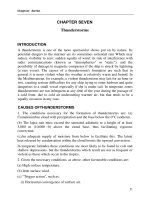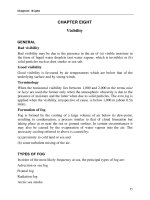BÀI GIẢNG KHÍ TƯỢNG THỰC HÀNH CHƯƠNG 8 VÀ 9
Bạn đang xem bản rút gọn của tài liệu. Xem và tải ngay bản đầy đủ của tài liệu tại đây (66.13 KB, 7 trang )
CHAPTER 8 Observation of Sea Surface Temperature
CHAPTER 8
Observation of Sea Surface Temperature
Sea surface temperature plays an important role in understanding the interactive relation
between the atmosphere and the ocean. The difference between the air temperature and the sea
surface temperature gives a basic measure of the vertical stability of the atmosphere and the heat
exchange between the atmosphere and the ocean. The sea surface temperature should therefore
be very carefully observed.
The temperature to be observed is that of the sea water at the depth of 1-2 m in the nearsurface mixing layer underlying the ocean skin and is representative of general oceanic
conditions. The scale of your sea-water thermometer should be read to the order of O.l°e.
The sea surface temperature is normally observed by one of the following ways:
1) Measuring the temperature of the condenser intake water;
2)Exposing an electrical thermometer to the sea-water either directly or through the hull;
3) Measuring the temperature of a sample of the sea-water with a sea-bucket.
The methods 3) and 1) have been used for many years. Recently, as the speed and
dimension of ships have increased, method 2) has been more widely used.
8.1 Intake method
The intake sea-water temperature is measured by a thermometer provided within the intake
pipe when the ship is built.
When a direct-reading thermometer is installed in cramped conditions the observer should
be warned of the possibility of error in his readings due to parallax. A distant reading system
with the display elsewhere (e.g. in the engine room or on the bridge) overcomes this problem.
The observer should also be aware that for ships of deep draught, or when a marked temperature
gradient exists within the sea surface layer, intake temperature readings usually differ
considerably from those close to the sea surface. The intake temperature should not be taken
when the ship is stationary, for the cooling water may not be circulating then.
In addition to the above, the temperature of the intake pipe may change due to the heat of
the engine room. Thus this method is not necessarily appropriate for the observation of the seasurface temperature. However, it is adopted to some extent in consideration of its safe and
convenient ways.
8.2 Hull-attached thermometer method
The sensor in this method is mounted either externally in direct contact with the sea using a
"through-the-hull" connection, or internally (the "limpet" type) attached to the inside of the hull.
Such hull-attached thermometer provides a very convenient and accurate means of measuring
sea-surface temperature. Its distant-reading device is installed in a cabin for observation.
The sensor has to be located forward of all discharges at a depth of 1 - 2 m below the waterline. When large changes of draught can occur, more than one sensor may be needed.
59
CHAPTER 8 Observation of Sea Surface Temperature
8.3 Sea-bucket method
In this method, a preparatory process to haul sea-water by a sea-bucket (especially a simple bucket
or a canvass bucket) lowered over the side of the ship and then to pour it away should be repeated
several times to make the temperature of the bucket attain the same value with that of the sea-water
before a sample of a full bucket of sea-water is hauled on board to obtain its temperature by a
thermometer. The sample should be taken near the bow, from the leeward side of the ship during
navigation, from the windward side while at anchor, and well forward of all outlets. The thermometer
should be read as soon as possible after it has attained the temperature of the water sample. When not
in use the bucket should be hung in a shady place to drain.
60
CHAPTER 9 Observation of Ocean Waves
CHAPTER 9 Observation of Ocean Waves
Navigation of a ship is most profoundly affected by winds and waves. Needless to say,
correct information on ocean waves is essential for disaster prevention and economical
navigation. Recent development in the observation by satellites not the least diminishes the
important role of the observation of ocean waves by ships. The data of ocean waves observed by
ships contribute to the analysis and forecasting of ocean waves and are also utilized for
statistical studies in the climatology of ocean waves.
9.1 Classification of ocean waves
Due to various reasons, thousands of waves with different wave heights and wave periods
give rise on the ocean. The sea surface is incessantly moving up and down. Among such waves,
those caused by winds over the sea surface are called ocean waves and ocean waves have
periods between around 1 second and about 30 seconds.
Ocean waves are generally classified into wind waves (or sea) and swell. Wind waves and/
or swell change into surfs in approaching a coast or into tidal races in colliding with tidal or
ocean currents.
(1) Wind waves (or Sea)
The system of waves raised by the local wind blowing at the time of observation is usually
referred to as "wind waves" or "sea".
Development of wind waves depends on three characteristics of wind: wind speed, fetch (the
distance along which a wind is blowing straight) and duration (the time during which a wind
with an almost fixed wind direction and speed is blowing along a fetch).
(2) Swell
Waves not raised by the local wind blowing at the time of observation, but due either to
winds blowing at a distance or to winds that have ceased to blow, are referred to as "swell".
Fig.9.1 shows a schematic view of wind waves (sea) with sharp crests and swell with gentle
ones.
9.2 Characteristics of ocean waves
Major characteristics of ocean wave are as follows:
1) Wave direction: the direction from which the waves come.
2) Wave period: the time between the passage of two successive wave crests past a fixed
point. It is equal to the wave length divided by the wave speed.
3) Wave height: the vertical distance between trough and crest. (see Fig. 9.2)
4) Wave length: the horizontal distance between successive crests or troughs. It is equal to the
wave period multiplied by the wave speed. (see Fig. 9.2)
5) Wave speed: the distance traveled by a wave in a unit of time. It is equal to the wave
length divided by the wave period.
Among these characteristics, the observations should include the measurement or estimation
of 1),2), and 3) of the above in respect of each distinguishable system of waves, i.e. wind waves
(sea) and swell.
9.3 Non-instrumental observation
62
CHAPTER 9 Observation of Ocean Waves
Bearing in mind the distinction between wind waves (sea) and swell, the observer should
differentiate between the recognizable wave systems, on the basis of the direction, the appearance
and the period of the waves.
(1) Direction
The direction (one of the 36 directions) from which the waves are coming is most easily
found by sighting along the wave crests and then turning 90° to face the approaching waves. The
observer is then facing the direction from which the waves are coming.
(2) Period
Measurement of wave period is made in the unit of second by a stopwatch. The observer
notes some object floating on the water at some distance from the ship: if nothing better is
available, a distinctive patch of foam can usually be found which remains identifiable for the few
minutes required for the observation.
He starts his watch when the object appears at the crest of the wave. As the crest passes on,
the object disappears into the trough, then reappears on the next crest, etc. The time at which the
object appears to be at the top of each crest is noted. The observations are continued for as long as
possible; they will usually terminate when the object becomes too distant to identify, on account
of the ship's motion. Obviously the longest period of observation will be attained by choosing an
object initially on the bow as far off as it can be clearly seen.
Another method is to observe two or more distinct consecutive periods from an individual
group while the watch is running continuously; with the passage of the last distinct crest of a
group or the anticipated disappearance of the object, the watch is stopped, then restarted with the
passage of the first distinct crest of a new group. The observer keeps count of the total number of
periods until he reaches 15 or 20 at least.
With observation of a period less than five seconds and low wind velocity, the above
observation may not be easily made, but such waves are less interesting than those with longer
periods.
(3) Height
With some experience fairly reliable estimates can be made. For estimating the height of
waves having wave lengths much shorter than the ship, the observer should take up a position as
low down in the ship as possible, preferably amidships where the pitching is least, and on the side
of the ship from which the waves are coming. Use should be made of the intervals which occur
every now and then, when the rolling of the ship temporarily ceases.
In case of waves longer than the ship, the preceding method fails because the ship as a whole
rises over the wave. Under these circumstances the best results are obtained when the observer
moves up or down in the ship until, when the ship is in the wave trough and vertical, the
oncoming waves appear just level with the horizon (see Fig.9.3). The wave height is then . equal
to the height of the observer above the level of the water beneath him (a). If the ship is rolling,
care should be taken to ensure that the approaching wave is in line with the horizon at the instant
when the ship is vertical, otherwise the estimate of height will be too large or too small (b).
63
CHAPTER 9 Observation of Ocean Waves
By far the most difficult case is that in which the wave length exceeds the length of the ship but
the wave height is small. The best estimate of height can be obtained by going as close to the water as
possible, but even then the observation can only be rough.









